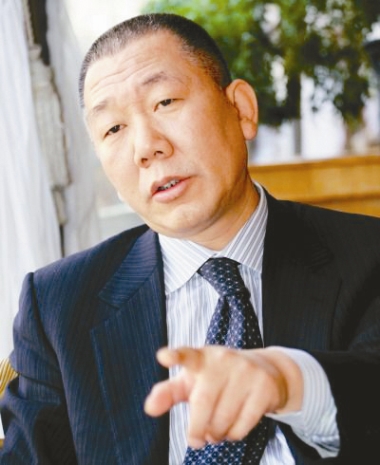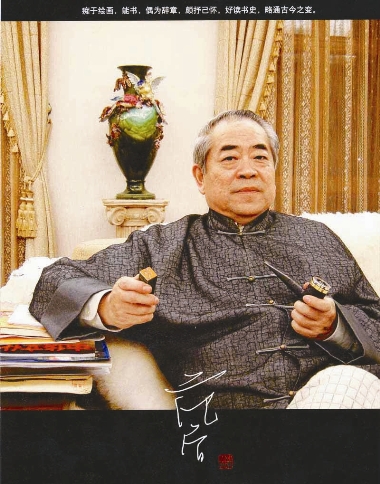|


Guo Qingxiang warned about the consequences of lack of criticism. “The absurdly high prices of some art pieces have misled the public, who have only a limited knowledge of art. Some manipulated the market and pushed up the prices of their work as if it’s the stock market. Some artists profit hugely from the maneuvers. With people buying the most expensive instead of the best stuff, this will have a very bad influence on art students and endanger the future of Chinese art.”
INSTEAD of announcing its verdict in court, Changping District People’s Court in Beijing sent a letter to art critic Guo Qingxiang last week ordering him to make a written apology to Chinese painter Fan Zeng and pay 70,000 yuan (US$10,700) in compensation for damaging the artist’s reputation. Guo confirmed that he would appeal. Fan has not yet commented.
In a high-profile lawsuit in April, Fan took art critics Guo Qingxiang and Xie Chunyan to court after the two published reviews in the Shanghai-based Wenhui News insinuating that Fan was not as talented as some had thought. Fan also unsuccessfully sued the newspaper.
Fan, aged 73, is a renowned artist whose paintings sell at more than 100,000 yuan per square chi (about 0.11sqm). A collector and researcher of Chinese painting and calligraphy, Guo is known for his insistence upon standards and his relentless candor.
“Guo’s essay, published in May last year, criticized Fan’s painting, calligraphy, poetry and character, thus influencing the public’s evaluation of the artist and causing him to suffer psychologically,” the verdict said. “The court deems Fan’s requirements to be reasonable, asking for an apology and a certain amount of compensation.”
Fan had originally asked for 5 million yuan from Guo.
“Guo had purchased paintings from Fan. With business interest involved, Guo cannot justify his argument that his essay was purely for artistic criticism,” the verdict said.
Guo said the verdict was unfair but not unexpected. “‘Assembly-line’ paintings beat thoughtful art criticism in the first trial, but I will appeal,” he said. “There is a clear line between defamation and criticism, but the Changping court confused the boundary and set a bad example. At least they should announce the verdict in public.”
Guo questioned the logic of the verdict. “If I cannot criticize him just because I purchased his paintings, is it true that an average consumer cannot complain if he bought a shoddy commodity? In my case, the manufacturer -— instead of processing the complaints properly — sued the consumer, and the court has told the consumer to shut up.”
The critic also questioned the verdict that held him liable but exempted Wenhui News. “If I was wrong, the newspaper was also responsible.” Guo said he thought the verdict was contradictory.
Despite the verdict, the critic insisted Fan’s “assembly-line” paintings cannot pass as good artwork. “A court verdict doesn’t have a final say on the artistic value of a painting,” he said.
“An authentic piece of art is the materialization of the artist’s feelings, thoughts, the spirit of his times and his creativity,” Guo said.
“Fan’s ‘assembly-line’ routine produces paintings similar to the products of a skillful worker, but they lack artistic value and genuine social insight.”
The critic warned about the consequences of lack of criticism. “The absurdly high prices of some art pieces have misled the public, who have only a limited knowledge of art. Some manipulated the market and pushed up the prices of their work as if it’s the stock market. Some artists profit hugely from the maneuvers. With people buying the most expensive instead of the best stuff, this will have a very bad influence on art students and endanger the future of Chinese art.”
Guo said he had no interest in judging the personality of Fan. “What interests me is the value of Fan as an artist. His reputation in other respects are decided by his behavior and actions, which speak for themselves,” the critic said.
“He has such a heavy output that I, as a critic, need to stand out and say something for the interest of misled buyers. Critics, like artists, have the responsibility of letting authentic art pieces pass on to future generations.”
Fu Minrong, who represented Wenhui News for the case, will serve as Guo’s lawyer in the appeal.
“The first verdict mistook art criticism for defamation. I am curious how people will respond to that in the media,” Fu said.
Several Shenzhen lawyers and artists share Fu’s views.
“According to the rulings of the Supreme People’s Court in 1993, if what’s addressed in a piece of criticism is fact, and there are no contents attacking the other person’s character, it cannot count as defamation,” said Liu Jinxing, a Shenzhen lawyer.
“Guo has given proof for Fan’s ‘assembly-line’ painting routine, which is fact. The use of language such as ‘not so talented’ and ‘hypocritical’ does not attack Fan’s character. So the first-trial verdict is not right,” Liu said.
Zhang Shizeng, former editor-in-chief of Chinese Fine Art, thinks that the Chinese art circle lacks a critical voice. “All artists, including Fan and other big names, should allow themselves to be criticized. I read Guo’s essay and thought it a good start.”
Kong Xiaobing with Shenzhen Art Museum said the verdict was predictable because a powerful group has invested heavily in Fan. “They would not allow their interest to be undermined,” he said.(Li Dan)
|

